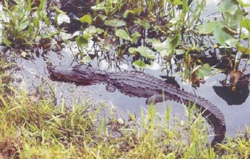 Scientific Name
Scientific Name
Alligator mississippiensis
Common Names
American Alligator, gator, common alligator
Average Size
11 ft. in length
795 lbs. in weight
Habitat
Alligators occupy a variety of wetland habitats in Georgia. They are found in marshes, swamps, rivers, farm ponds and lakes in the wild, but also have been found in ditches, neighborhoods, drainage canals, roadways, golf course ponds and sometimes in swimming pools. During the courtship and breeding season, April to May, alligators prefer open waters. During the remainder of the year, males prefer open and deep waters while females seek out nesting habitat in shallow, heavily vegetated and secluded areas.
Range & Description
Alligators occur from the southern tip of Texas to the northeastern part of North Carolina. There are approximately 200,000 alligators in Georgia and are typically found south of the fall line (which roughly connects the cities of Columbus, Macon and Augusta). There is no evidence that alligator populations reproduce north of the fall line and any found in these areas have probably been relocated there by humans. Alligators usually remain in the area where they were born for two to three years and then begin looking for their own range. Females generally have small home ranges while a male may occupy a range of more than two square miles. Severe drought conditions may cause alligators to move considerable distances in search of suitable waters.
Alligators can live up to 60 years in captivity but in the wild they rarely live more than 50 years. Male alligators can grow up to 16 feet in length, although 14 footers are rare, and female alligators can grow up to 10 feet. After breeding, females lay an average of 35 to 40 eggs that incubate for about 65 days. Alligators are about eight to ten inches in length when born. About 20 percent of the young will survive to maturity, the others fall victim to predators such as raccoons, birds, snakes, otters and other alligators. They grow approximately eight to ten inches per year for the first few years and will reach sexual maturity when they reach about six feet in length. Large alligators can reach weights of over 800 pounds. Alligators are carnivores and will eat almost anything they can catch. During the first few years their diet consists mainly of small prey such as snails, crayfish, frogs, insects and other invertebrates. Depending on their size, larger alligators may eat fish, turtles, snakes, waterfowl, raccoons, beavers and otters. Alligators also feed on carrion and given the opportunity they also may eat pets and smaller domestic animals, such as goats and pigs.
Benefits
Alligators are important in nature. They help maintain the population balance of certain prey species and they help shape and modify habitats. During times of severe drought, alligators are known to dig holes (gator holes) to concentrate water. This helps the alligator survive, and also helps many other species of plants and animals in the area.
Can American alligators be found in salt water?
Yes, they CAN be found in salt water!
Human Incidents
In 1989, the Georgia Department of Natural Resources (GA/DNR) initiated a nuisance alligator program that allows licensed agent trappers to capture and harvest specific nuisance alligators over four feet in length. A nuisance alligator is one that exhibits aggressive behavior toward humans, shows symptoms of some debilitating illness or injury, inhabits recreational waters intended primarily for swimming or attacks domestic animals. From 1980-October 2001, there only have been eight reported cases of alligator attacks on humans in Georgia. There have been no fatalities. Six of these incidents happened as a result of the human stepping on or otherwise contacting a submerged alligator. The remaining two incidents were a result of the alligator mistaking the human for prey.
GO BACK A PAGE
RETURN TO HOME